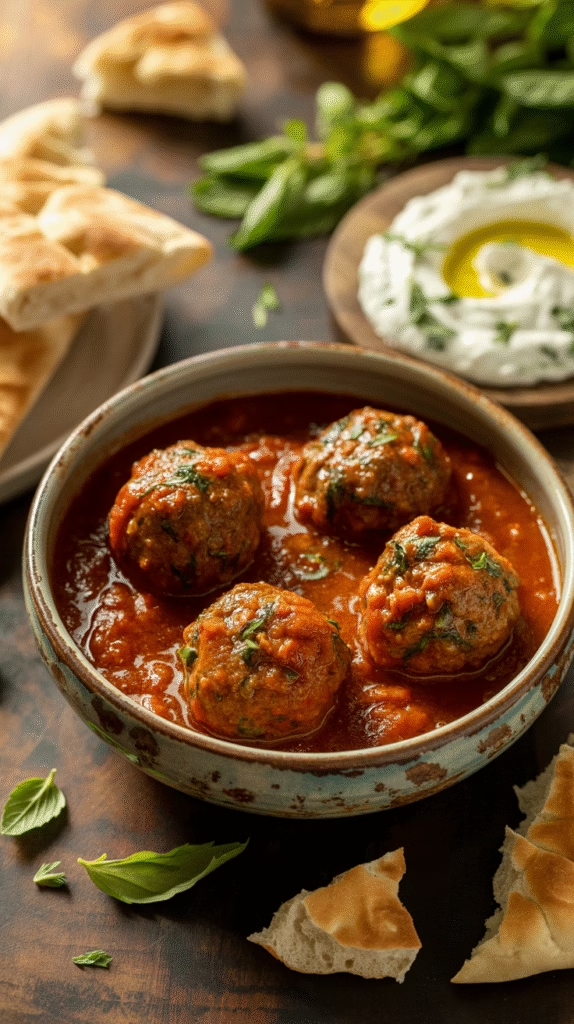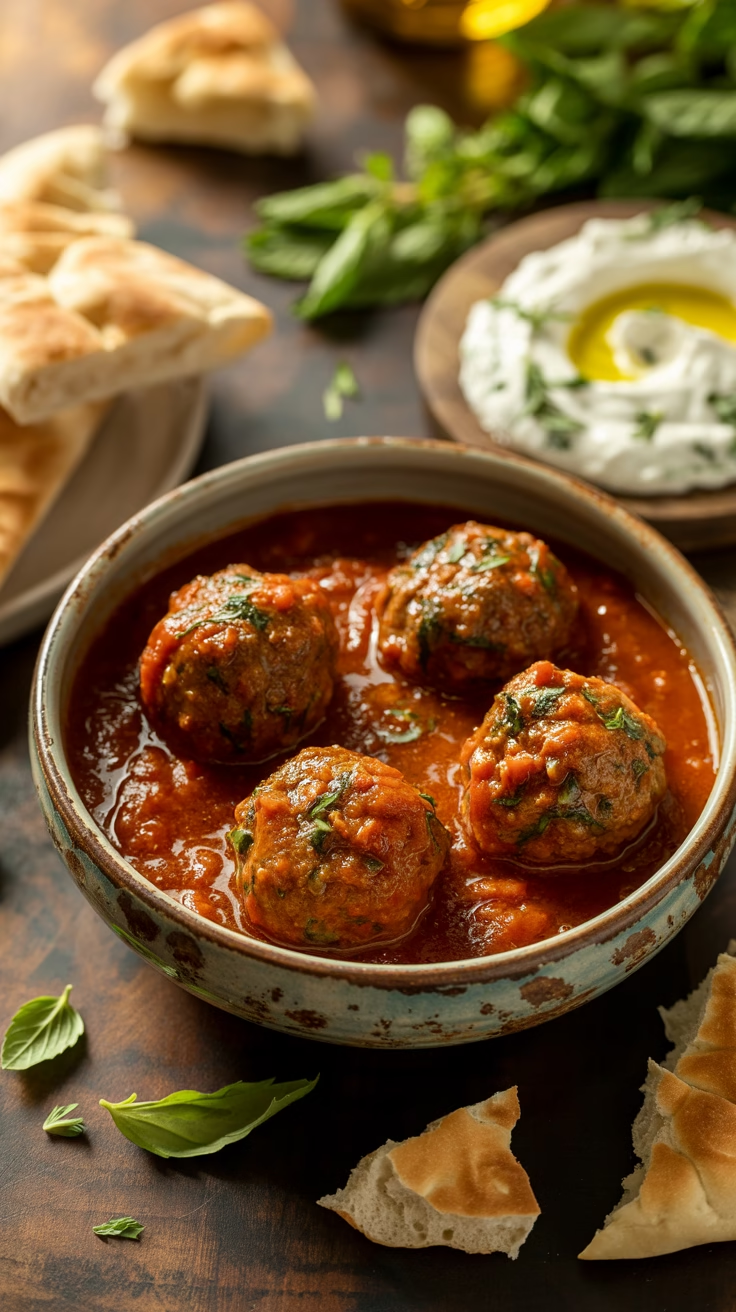Ever bitten into a lamb meatball so perfectly seasoned it made you question every beef meatball you’d ever eaten? Yeah, me too. That’s exactly what happened when I first tried authentic Greek lamb meatballs at my neighbor’s dinner party. I walked in expecting the usual spaghetti-and-meatballs situation, but what I got was a flavor explosion that completely changed my meatball game forever.
Let me tell you something about lamb meatballs: they’re not just fancy beef meatballs with a twist. They’re an entirely different beast (pun intended), packed with rich, earthy flavors that’ll make your taste buds do a little happy dance. And the best part? They’re surprisingly easy to make once you know the secrets.
Understanding the Appeal of Lamb Meatballs
Lamb brings unique characteristics to meatball preparation that set it apart from other ground meats. The natural fat content ensures exceptional moisture retention, while the distinctive flavor profile complements Mediterranean seasonings beautifully. Professional chefs often prefer lamb for its forgiving nature – it’s harder to overcook and maintains tenderness even when prepared by home cooks.
From a nutritional standpoint, lamb offers superior protein quality, higher iron content, and essential B vitamins compared to many conventional ground meats. When sourced from grass-fed animals, lamb provides additional omega-3 fatty acids and conjugated linoleic acid.
Cultural Significance in Mediterranean Cuisine
Throughout the Mediterranean region, lamb holds cultural importance that extends beyond mere sustenance. In Greek cuisine, lamb meatballs (keftedes) represent comfort food at its finest. Turkish köfte showcases similar preparation techniques with regional spice variations, while Middle Eastern kibbeh demonstrates the versatility of seasoned lamb preparations.

The Complete Lamb Meatball Recipe
This recipe yields 4-6 servings and requires approximately 45 minutes from preparation to completion. The technique emphasizes proper seasoning balance and cooking method to achieve restaurant-quality results.
Essential Ingredients
For the Meatballs:
- 2 pounds ground lamb (preferably 80/20 fat ratio)
- 1 large yellow onion, finely diced
- 4 garlic cloves, minced
- 1/2 cup fresh breadcrumbs
- 1 large egg, beaten
- 1/4 cup fresh parsley, finely chopped
- 2 tablespoons fresh mint, chopped
- 1 teaspoon dried oregano
- 1 teaspoon ground cumin
- 1/2 teaspoon ground coriander
- 1/2 teaspoon smoked paprika
- Kosher salt and freshly ground black pepper
- 2 tablespoons extra-virgin olive oil
For the Mediterranean Sauce:
- 1 can (14 oz) high-quality crushed tomatoes
- 3 garlic cloves, minced
- 1 teaspoon dried oregano
- 1/2 teaspoon smoked paprika
- 1/4 cup dry red wine (optional)
- 1 teaspoon honey
- Salt and pepper to taste
- 2 tablespoons extra-virgin olive oil
Professional Preparation Method
Foundation Preparation: Heat olive oil in a large skillet over medium heat. Add diced onion and cook until translucent, approximately 5 minutes. Remove from heat and allow to cool completely. This cooling step prevents the egg from cooking prematurely when mixed with the meat.
Meatball Assembly: In a large mixing bowl, combine ground lamb, cooled onions, minced garlic, fresh breadcrumbs, beaten egg, and all herbs and spices. Mix ingredients by hand until just combined – overmixing develops gluten strands that create tough meatballs. The mixture should hold together when pressed but remain relatively loose.
Shaping and Initial Cooking: Form the mixture into uniform balls approximately 1.5 inches in diameter. This size ensures even cooking while maintaining moisture. Heat olive oil in the same skillet over medium-high heat. Brown meatballs on all sides, approximately 6-8 minutes total, developing a golden crust that adds flavor complexity.
Sauce Development: Remove meatballs temporarily and add olive oil to the pan. Sauté minced garlic for 30 seconds before adding crushed tomatoes, oregano, paprika, and honey. If using wine, add it now and simmer for 2 minutes to cook off alcohol. Return meatballs to the sauce, cover, and simmer for 15-20 minutes until cooked through.
Advanced Techniques for Superior Results
Breadcrumb Selection and Preparation
Fresh breadcrumbs significantly impact final texture. Process day-old bread in a food processor until coarse crumbs form. Store-bought breadcrumbs absorb excessive moisture and create dense results. Fresh breadcrumbs provide the ideal binding while maintaining light texture.
Herb Optimization
Fresh herbs deliver superior flavor compared to dried alternatives. The mint-parsley combination represents classic Mediterranean pairing, but variations like fresh dill or rosemary add interesting complexity. Always taste the raw mixture before cooking to adjust seasoning – this prevents disappointment later.
Temperature Control and Timing
Lamb should reach an internal temperature of 160°F for food safety. Use an instant-read thermometer for accuracy. The browning phase creates Maillard reactions that develop complex flavors, while the simmering phase ensures thorough cooking and sauce integration.
Resting Period Importance
Allow the mixed meatball mixture to rest in the refrigerator for 30 minutes before shaping. This resting period allows flavors to meld and makes the mixture easier to handle. The mixture can be prepared up to 24 hours in advance for improved flavor development.
Versatile Serving Applications
Traditional Mediterranean Presentation
Serve over aromatic rice pilaf with a dollop of tzatziki and warm pita bread. Add a simple Greek salad featuring tomatoes, cucumbers, olives, and feta cheese. This combination provides balanced flavors and textures that complement the rich meatballs.
Contemporary Fusion Approaches
Lamb meatballs adapt well to modern presentations. Serve over pasta with the tomato sauce, garnished with fresh basil and crumbled feta. Alternatively, create grain bowls with quinoa, roasted vegetables, and tahini dressing for a nutritious, Instagram-worthy meal.
Appetizer Presentations
Form smaller meatballs (1-inch diameter) for cocktail parties. Serve with toothpicks alongside yogurt-based dipping sauces. Popular sauce combinations include cucumber-yogurt with garlic, or harissa-yogurt for heat lovers.

Common Preparation Mistakes
Overmixing the Meat
The most frequent error involves overmixing the meat mixture. This develops proteins excessively, creating tough, dense meatballs. Mix ingredients just until combined, then stop immediately.
Inadequate Seasoning
Many home cooks under-season lamb meatballs, fearing the meat’s natural flavor. Proper seasoning enhances rather than masks lamb’s characteristics. Taste the raw mixture and adjust accordingly.
Skipping the Browning Step
The initial browning creates flavor foundations that cannot be replicated through other cooking methods. This step is essential for developing depth and complexity in the final dish.
Incorrect Pan Selection
Using undersized pans creates overcrowding, which generates steam instead of proper browning. Use large skillets that accommodate meatballs in a single layer.
Storage and Reheating Guidelines
Lamb meatballs actually improve in flavor after overnight refrigeration. Store in covered containers for up to 3 days refrigerated, or freeze for up to 3 months. For optimal reheating, use a 350°F oven for 15 minutes until heated through. Microwave reheating works but compromises texture.
Creative Variations and Adaptations
Middle Eastern Influence
Incorporate cinnamon and allspice for warmth, then serve with tahini sauce and pomegranate seeds. This variation reflects Lebanese and Syrian culinary traditions.
Spicy Mediterranean Style
Add harissa paste or Aleppo pepper for heat. Start conservatively – these spices intensify during cooking. Spicy versions pair excellently with cooling yogurt sauces.
Herb-Crusted Presentation
Roll shaped meatballs in a mixture of chopped fresh herbs and breadcrumbs before cooking. This technique creates textural contrast between the crispy exterior and tender interior.
Wine Pairing Recommendations
Medium-bodied red wines complement lamb meatballs exceptionally well. Côtes du Rhône, Chianti, or Grenache-based blends provide earthy notes that harmonize with the meat’s natural flavors. For white wine preferences, full-bodied options like Viognier or white Rioja offer sufficient richness to stand up to lamb’s intensity.
Nutritional Considerations
A typical serving (4-5 meatballs) provides approximately 350 calories, 25 grams of protein, and significant amounts of iron, zinc, and B-vitamins. Lamb’s complete amino acid profile makes it an excellent protein source for muscle maintenance and overall health.
Quality Ingredient Selection
Source lamb from reputable suppliers, preferring grass-fed options when available. The 80/20 fat ratio provides optimal moisture and flavor without excessive grease. Fresh herbs make a noticeable difference in final flavor, so avoid dried substitutes when possible.
Make-Ahead Strategies
These meatballs excel in meal preparation scenarios. Options include:
- Preparing the mixture 24 hours ahead for flavor development
- Shaping and freezing uncooked meatballs for up to 3 months
- Cooking completely and freezing in sauce for ready-to-reheat meals
Professional Tips for Consistent Results
Uniform sizing ensures even cooking – use a small ice cream scoop for consistency. Maintain medium-high heat during browning to develop proper crust without burning. The sauce should barely simmer during the final cooking phase to prevent meatballs from becoming tough.
Troubleshooting Common Issues
Meatballs falling apart: Add more breadcrumbs gradually until the mixture holds together properly.
Dense, heavy texture: Indicates overmixing – reduce handling time in future preparations.
Bland flavor: Usually results from under-seasoning or insufficient resting time.
Thin sauce: Simmer uncovered for additional minutes to concentrate flavors and reduce liquid.
The science improves results significantly. Fresh breadcrumbs and egg create an ideal binding matrix that maintains moisture without heaviness. The browning reaction (Maillard effect) develops complex flavors impossible to achieve through other methods.
The herb and spice selection specifically complements lamb’s natural flavor compounds. Cumin and coriander provide earthiness, while mint and parsley add brightness that balances richness.
Cultural Context and Modern Applications
Traditional Mediterranean preparations emphasize simplicity and quality ingredients. Modern interpretations can incorporate global flavors while respecting fundamental techniques. The key lies in understanding how different ingredients interact with lamb’s distinctive characteristics.
Conclusion
Mastering lamb meatballs requires attention to detail, quality ingredients, and proper technique. The investment in learning these methods pays dividends in consistently excellent results that will impress family and guests alike. Whether serving as a weeknight dinner or elegant entertaining option, perfectly prepared lamb meatballs represent the pinnacle of Mediterranean comfort food.
Lamb Meatballs Recipe
Course: Main, DinnerCuisine: MediterraneanDifficulty: Easy4-6
servings20
minutes25
minutes350
kcal45
minutesTender, herb-infused lamb meatballs simmered in a rich Mediterranean tomato sauce. This authentic recipe combines ground lamb with fresh mint, parsley, and aromatic spices like cumin and coriander for a flavor-packed meal that’s both comforting and elegant. The meatballs are first browned to develop a golden crust, then finished in a savory tomato sauce with hints of honey and smoked paprika. Perfect served over rice, pasta, or as appetizers with yogurt dipping sauce.
Ingredients
For the Meatballs:
2 lbs ground lamb
1 large yellow onion, finely diced
4 garlic cloves, minced
1/2 cup fresh breadcrumbs
1 large egg, beaten
1/4 cup fresh parsley, chopped
2 tbsp fresh mint, chopped
1 tsp dried oregano
1 tsp ground cumin
1/2 tsp ground coriander
1/2 tsp smoked paprika
Salt and pepper to taste
2 tbsp olive oil
- For the Sauce:
1 can (14 oz) crushed tomatoes
3 garlic cloves, minced
1 tsp dried oregano
1/2 tsp smoked paprika
1/4 cup red wine (optional)
1 tsp honey
Salt and pepper to taste
2 tbsp olive oil
Directions
- Prep the onion: Sauté diced onion in olive oil until translucent (5 minutes). Cool completely.
- Mix meatballs: Combine lamb, cooled onions, garlic, breadcrumbs, egg, herbs, and spices in a large bowl. Mix by hand until just combined.
- Shape and brown: Form into 1.5-inch balls. Brown in olive oil over medium-high heat, 6-8 minutes total.
- Make sauce: In the same pan, add olive oil, garlic, tomatoes, oregano, paprika, wine, and honey. Simmer 2 minutes.
- Finish cooking: Return meatballs to sauce, cover, and simmer 15-20 minutes until cooked through (160°F internal temp).
Notes
- Use fresh breadcrumbs for best texture
Don’t overmix the meat mixture
Let mixture rest 30 minutes before shaping
Always brown meatballs first for flavor

